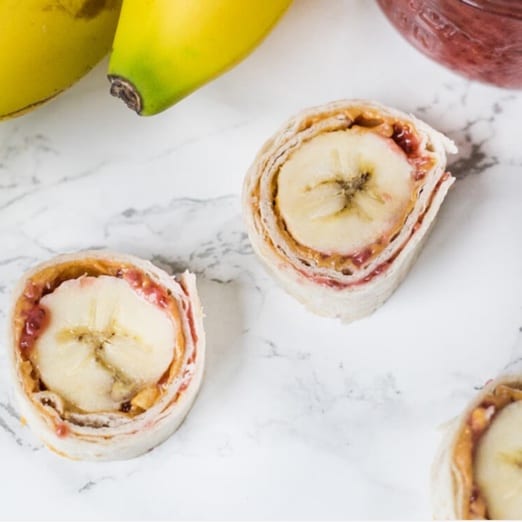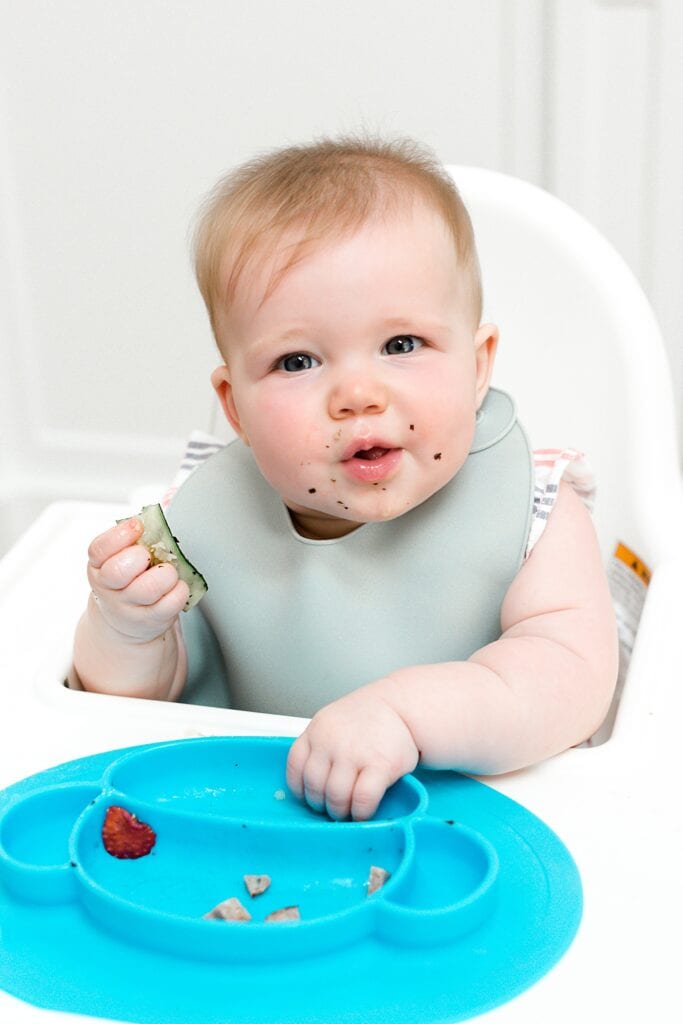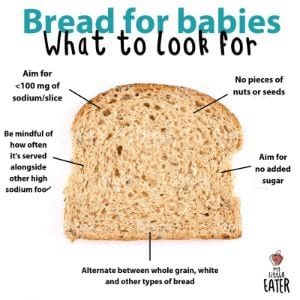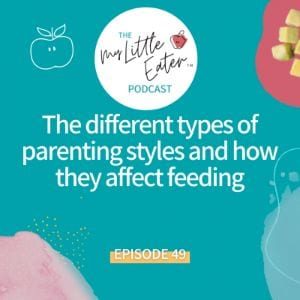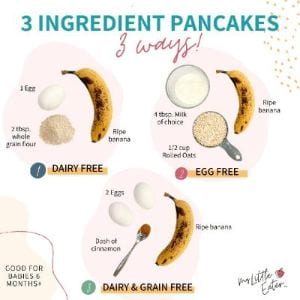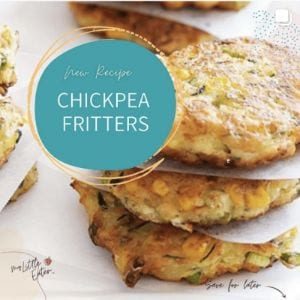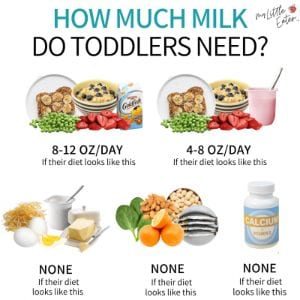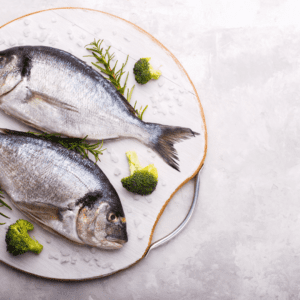
If I were to ask you what the most important nutrients are for pregnant moms, most of us think of folic acid, iron, and maybe Vitamin D if you’re super up-to-date on recommendations. If I asked what nutrients are important for babies starting solids, many are quick to jump in and say “Ooh I know…iron!”. All these are truer than true…but there’s another SUPER important nutrient that I want to talk about today that’s actually essential for growth and development. OMEGA-3’s! Specifically…DHA!
DHA is one of the three types of Omega-3’s, and is most important during pregnancy and infancy because it’s crucial in the development of your baby’s brain, eyes, and so much more. In fact, it’s so important that I wish all doctors and pamphlets and vitamins would automatically talk about this nutrient the second a woman finds out they’re pregnant! I’m on a mission to make sure it’s included as part of a healthy pregnancy diet and is regularly offered on the menu for starting solids.
Let’s take a look at what DHA is, how much you need, and what foods can help you reach that goal!
What is DHA? Why is it important?
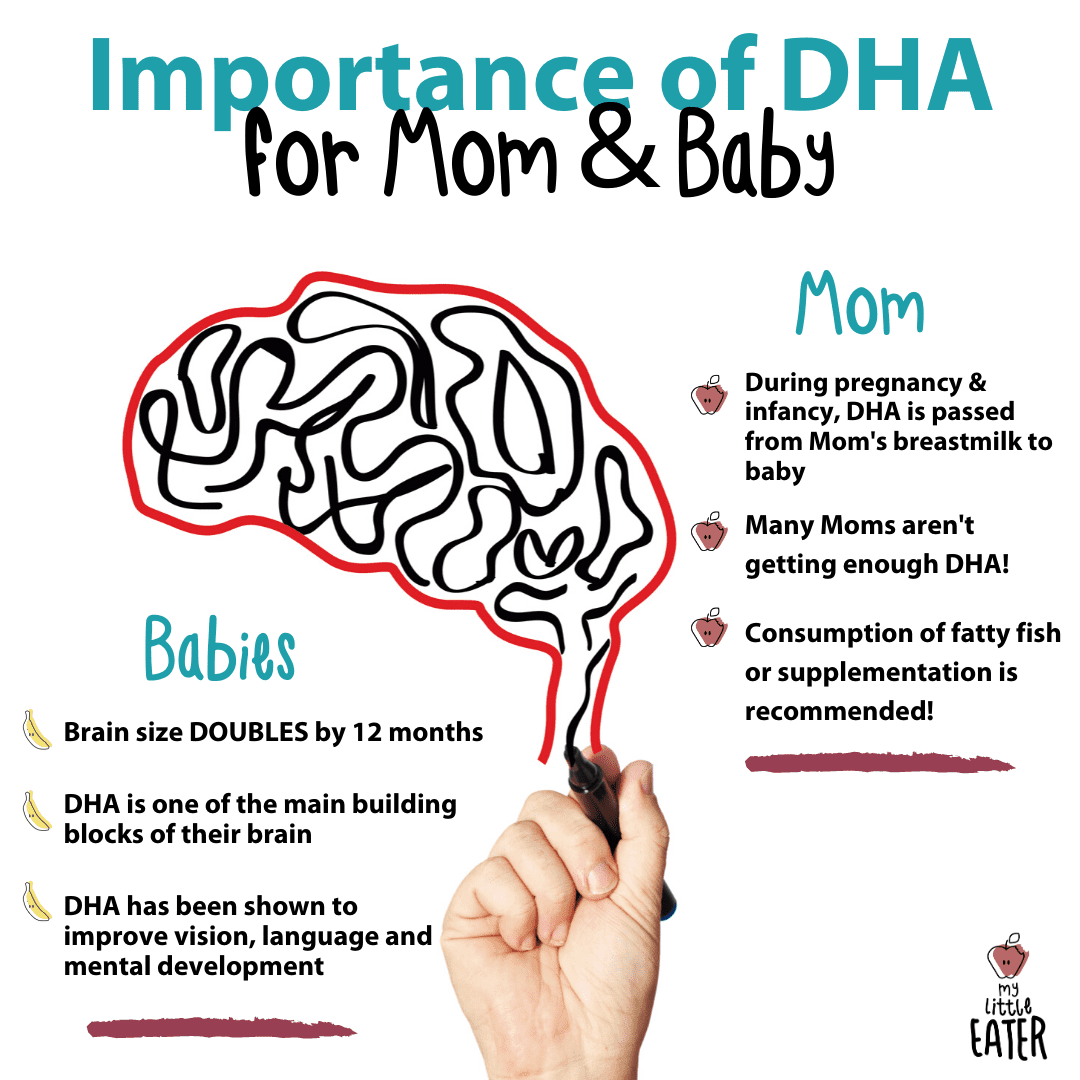
In short, Omega-3’s are fatty acids that are a type of healthy fat and play an essential role in our bodies. And what I mean by essential is that your body can’t make them. It has to rely on you to supply them through the food you eat or supplements you take. The Omega’s consist of three different fatty acids that are important as part of a healthy diet – alpha-linolenic acid (ALA), docosahexaenoic acid (DHA) and eicosapentaenoic acid (EPA). Fancy, I know.
Although they’re all important, DHA has been found to be the most important during pregnancy and infancy.
Here’s why…
During the third trimester, after birth, and right through the first year, your baby grows like a weed. The brain grows faster than ever, actually doubling its size around 12 months, and tripling in size by age 3. How crazy is that?! Since DHA is one of the main building blocks for the brain, we need to make sure your baby gets enough of it as they continue to grow. The good news is that babies will get all the DHA they need from mom during pregnancy, and continue to get more through mom’s breast milk while breastfeeding. But that means a healthy diet is crucial, not only for babies, but for moms too!
What can happen if I’m deficient during pregnancy?
There has been lots of research to show that if mothers are deficient in DHA during pregnancy, it’s not just their health that is at risk, but also their baby has greater risks of having a slower development. Some of the areas in this research included vision and language development – with babies being tested at 2 months for vision, and then for language development at 14 and 18 months. The research essentially found that babies with mothers who were deficient in DHA during pregnancy were more likely to have slower vision and language development than babies with mothers who had enough DHA to support their growth.
More research shows babies that were supplemented with the recommended amount of DHA (between 0.2 and 0.5 weight percent of total fat) from infant formula were shown to have improved…
- ability to pay attention
- problem solving skills
- vision development
- mental development in infancy
- immune function, with decreased upper respiratory infections and allergies
DHA supplementation in preterm infants also showed improved cognitive development at 10 years of age – especially in girls. Specifically, increased verbal IQ, full-scale IQ, and memory scores at 10 years of age.
With all of its benefits, DHA isn’t something you want to risk not including in your diet during pregnancy! I’m going to help you feel reassured that you can get as much as possible during this exciting time!
Recommendations for pregnant women & breastfeeding women
Many pregnant and breastfeeding women simply aren’t getting enough DHA for many reasons, and since it is passed on from mom to baby through breast milk, this is something that you want to prevent. The current recommendation for Canadian and American moms is: 2-3 servings of foods rich in DHA per week, which is equivalent to 8-12oz of fatty fish. You can also achieve this with a supplement of 250 mg/day DHA.
Recommendations for babies and toddlers
The current recommendations for infants 0-12 months is: 0.5g/day, and for 1-3 year olds the recommendation is: 0.7g/day. This will be achieved if Mom is getting her appropriate recommendations for DHA and is breastfeeding, OR baby has started solids and is eating 2 x 2 oz servings of fatty fish per week.
The best sources of DHA for you and your baby
DHA is mainly found in fatty fish and shellfish like: salmon, herring, sardines, and trout. Keep in mind, that if you’re pregnant, you’ll need to be careful about the amount of mercury you’re getting from seafood sources. High mercury containing fish like: fresh/frozen tuna, shark, swordfish, escolar, marlin, and orange roughy, are ones you should avoid completely during pregnancy and for your baby, up to 2 years old. Don’t be discouraged though! There are so many great fish sources that are low mercury, and can help you reach your DHA recommendations. Below are some of the low mercury fish options with the most DHA. Remember, the recommendation is that you eat 2-3 servings per week – with a serving being 4oz, or roughly the size of the palm of your hand.
- Salmon
- Trout
- Herring
- Pollock (Boston bluefish)
- Sole
- Founder
- Anchovy
- Char
- Hake
- Mullet
- Smelt
- Atlantic mackerel
- Lake white fish
If fish isn’t something you can stomach that often during pregnancy, there are also omega-3 enriched eggs, which typically provide 75-100mg of DHA per serving.
For babies who haven’t started solids yet, they rely on your breastmilk, or formula, to help them meet their needs. If you’re breastfeeding, the best thing you can do is to take care of yourself and make sure you are eating enough DHA rich foods for you and your baby! If you’re formula feeding, it’s important to look for a formula with 11.5 mg/100 mL of DHA, which is similar to the average level in breast milk.
If you’ve already started solids, then fish can no doubt be incorporated successfully in your baby’s diet, as long as it is served appropriately according to their progression with foods. One easy way you can serve fish to your baby if you’re in a time crunch and trying to stick to their feeding schedule, is to buy canned fish like salmon, and let them eat that instead. Since your baby’s sodium requirement is only 400mg per day, make sure you offer options with no added salt and, of course, make sure it is free of bones to prevent a choking hazard.
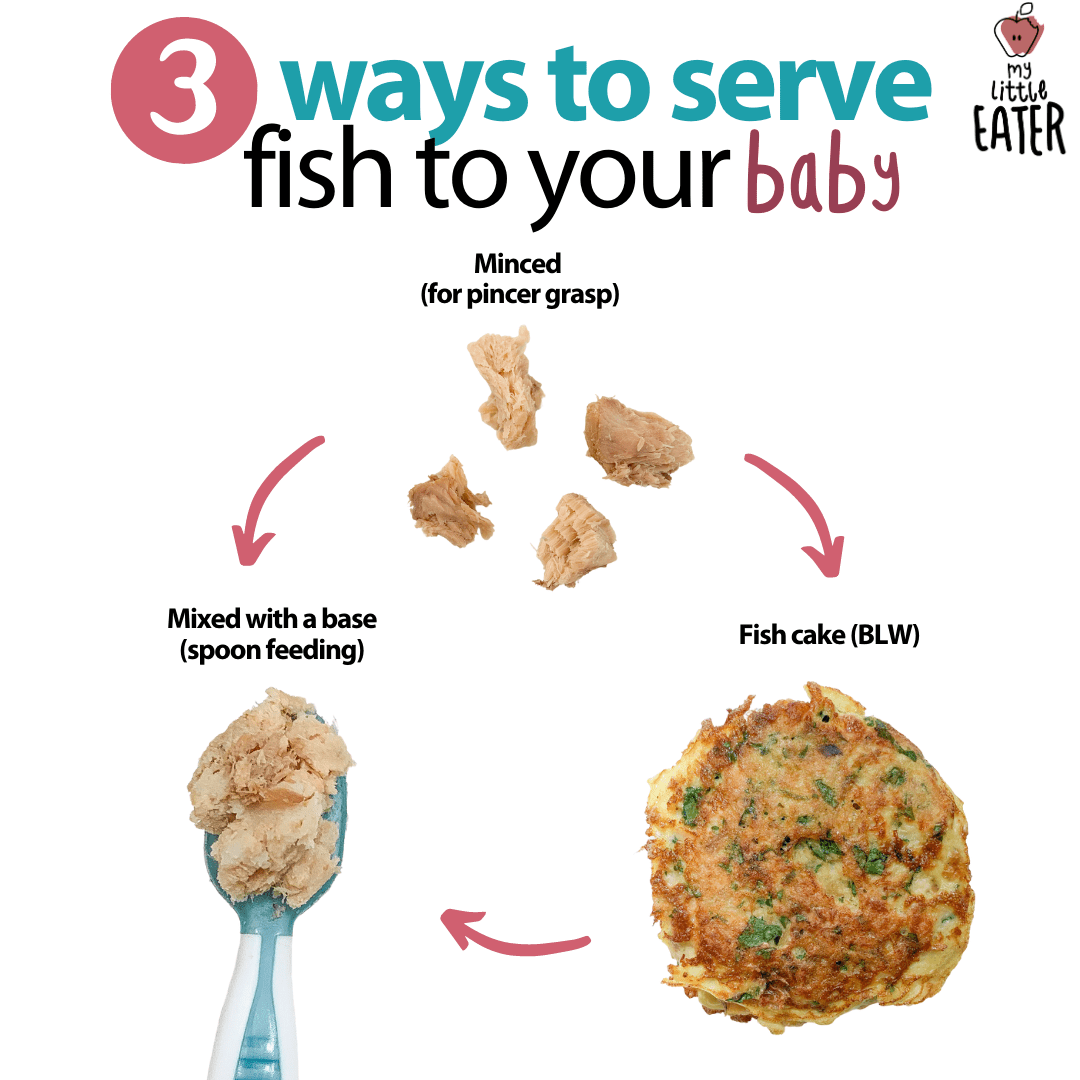
What about vegan and vegetarian mothers?
Since fish is completely cut out of a vegan diet, and can also be cut out of certain vegetarian diets, it can be really difficult to get enough DHA through diet alone. Fish is always the best source of DHA specifically, but walnuts and flax seed are great sources of Omega-3’s. Here’s the thing though… the type of Omega-3 found in these plant based sources is a type called ALA, which is a fatty acid that can be converted to DHA…but unfortunately your body has to work really hard to do so. So…it’s actually extremely hard to eat enough of these plant based sources of omega’s to get enough converted to DHA. For this reason, I’d recommend an Omega-3 supplement containing at least 200 mg/day. And, if you’re vegan, you can now find vegan friendly DHA supplements that are made using algae as the DHA source instead of fish.
Try to include fish in your weekly meal plan!
It’s one thing to know what we need to eat – it’s a whole other thing to actually implement what we know! Making sure you get the recommended amount of DHA for you and your baby is going to require some planning ahead. Many people like cooking fresh vs frozen fish – if this is the case, you will have to make sure you are purchasing your fish no earlier than the day before you plan on eating it. If you are purchasing it frozen, be sure to thaw the fish the night before in the fridge, or place it in a sealed plastic bag and immerse it in a bath of cold water until it defrosts. Planning ahead takes practice in order to make it a habit, but once you get the hang of it, it will become second nature!
The great thing about planning seafood for your meals, is that it’s one of the quickest and easiest types of food to prepare. When baked in the oven, fish can be ready in just under 20 minutes. Needless to say, for this reason alone, it’s become a weekly staple in our home.
Here’s my go-to salmon slider recipe to help give you inspiration for starting! It makes a great starter recipe for baby led weaning, can be made with fresh or canned salmon, and can be easily frozen for future meals!
Lime Cilantro Salmon Sliders
Makes 8 servings
Ingredients:
- 2 cans unsalted salmon in water
- 2 medium eggs
- Zest of 1 lime
- 1 tbsp. onion powder
- 1 tbsp. garlic powder
- 3 tbsp. chopped cilantro
- 1 tbsp. cooking fat (olive oil, coconut oil, butter, etc.)
Directions:
- Drain canned salmon and pat dry. Mix all ingredients (except cooking fat) together.
- Shape into sliders (about 3 tbsp. each).
- Heat skillet over medium heat. Add cooking fat, and pan fry sliders for 5 minutes on each side.
- Let cool and enjoy!
If you want to learn more about how to feed your baby so they eat all flavours and textures, while ensuring they get all the nutrients they need through food, my Baby Led Feeding online course is just the thing for you!
*Average level of DHA and ARA in worldwide breast milk is 0.32% and 0.47% (mean ± standard deviation of total fatty acids) based on an analysis of 65 studies of 2,474 women) †Dietitians of Canada recommends that infants being formula fed be given a formula with DHA consisting of at least 0.2% of total fatty acids.
References:
Brenna T. European consensus conference on recommendations for long chain polyunsaturated consumption for pregnant and lactating women (PERILIP). ISSFAL Newsletter. 2005;12:4-6.
Simopoulos AP, Leaf A, Salem N. Workshop on the essentiality of and recommended dietary intakes for omega-6 and omega-3 fatty acids. J Am Coll Nutr. 1999;18:487-489.
Georgieff MK. Nutrition and the developing brain: nutrient priorities and measurement. Am J Clin Nutr. 2007;85(suppl):614S–620S.
Hohmann C. Nutrition, brain and environment: How to have smarter babies? Indian Pediatr. 2003;40:213-220.
Gopalan C. Effect of nutrition on pregnancy and lactation.Bull World Health Organ.1962;26(2):203–211.
Mulder KA, King DJ, Innis SM. Omega-3 fatty acid deficiency in infants before birth identified using a randomized trial of maternal DHA supplementation in pregnancy. PLoS ONE. 2014:9(1): e83764. doi:10.1371/journal.pone.0083764.17.
Isaacs EB, Ross S, Kennedy K, Weaver LT, Lucas A, Fewtrell MS. 10-year cognition in preterms after random assignment to fatty acid supplementation in infancy. Pediatrics. 2011;128(4):e890-8. doi:10.1542/peds.2010-3153. Epub 2011 Sep 19.18.
Willatts P, Forsyth S, Agostoni C, et al. Effects of long-chain PUFA supplementation in infant formula on cognitive function in later childhood. Am J Clin Nutr. 2013; 98:519S-520S.19.
Colombo J et al.Long-term effects of LCPUFA supplementation on child-hood cognitive outcomes. Am J Clin Nutr. 2013;98(2):403-412.20.
Richardson AJ, Burton JR, Sewell RP, et al. Docosahexaenoic acid for reading, cognition and behavior in children aged 7–9 years: A randomized, controlled trial (The DOLAB Study).PLoS ONE. 2012; 7(9): e43909.21.Carlson SE, Colombo J, Gajewski BJ, et al.
DHA supplementation and pregnancy outcomes. Am J Clin Nutr. 2013;97(4):808-815.



